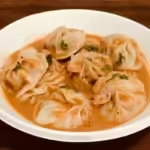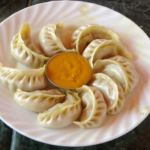In the world of comfort food, few dishes match the sheer pleasure and warmth of steamed momos. Originating from the Himalayan region, particularly Nepal and Tibet, momos have become a beloved staple across South Asia and beyond. These delectable dumplings offer a perfect blend of simplicity and sophistication, and their global popularity is a testament to their universal appeal.
A Brief History of Momos
The origins of momos can be traced back to the Tibetan plateau, where they were traditionally enjoyed by Tibetan and Nepali communities. The term “momo” itself is derived from the Tibetan word “momo,” meaning “steamed bun.” Traditionally, momos were filled with meat, often yak or lamb, but as they spread through the region, variations with vegetables and even cheese began to emerge.
The spread of momos beyond their native regions can be attributed to the migration of people and the growing popularity of South Asian cuisine. As momos traveled, they adapted to local tastes and ingredients, becoming a versatile dish that could be filled with everything from spicy chicken to hearty vegetables.
The Art of Making Steamed Momos
Making steamed momos is both an art and a science. The process begins with preparing the dough, which is typically made from all-purpose flour, water, and a pinch of salt. The dough is kneaded until it is smooth and elastic, then allowed to rest before being rolled out into thin circles.
The filling is where the magic happens. Traditional fillings include minced meat mixed with finely chopped vegetables, garlic, ginger, and a variety of spices. Vegetarian momos, on the other hand, might feature ingredients like cabbage, carrots, mushrooms, and tofu. The key to a great filling is balance—flavorful, yet not overpowering, and with a texture that complements the soft, steamed dough.
Once the filling is ready, it is placed in the center of each dough circle, and the edges are folded and pinched together to form a neat pleat. The momos are then placed in a steamer basket lined with parchment paper to prevent sticking and steamed for about 10-15 minutes until they are cooked through and have a delicate, translucent appearance.
The Steaming Process: Why It Matters
Steaming is the preferred method of cooking momos because it preserves their delicate texture and ensures that the dough remains soft and pillowy. Unlike frying or baking, steaming does not alter the flavor of the filling or add extra fat, making momos a relatively healthy option for those mindful of their diet.
The steaming process also allows the flavors of the filling to meld together, resulting in a harmonious taste experience. The moist heat helps the dough maintain its tenderness while infusing the filling with a savory, aromatic quality.
Pairing Momos with Dips and Sauces
One of the joys of eating momos is the array of dips and sauces that accompany them. The most common is the spicy tomato-based chutney, which provides a tangy and slightly fiery contrast to the mellow flavor of the dumplings. Another popular option is the sesame sauce, often made with ground sesame seeds, garlic, and chili, which adds a nutty depth to each bite.
For those who enjoy a bit more heat, a green chili sauce made from fresh cilantro, green chilies, and garlic can elevate the flavor profile of the momos. Soy sauce or vinegar-based dips also make excellent accompaniments, especially if you prefer a more subtle or tangy flavor.
The Cultural Significance of Momos
In many South Asian cultures, momos are more than just a dish; they are a symbol of hospitality and community. In Nepal and Tibet, momos are often served during festive occasions and social gatherings. They are a common sight at street food stalls and local eateries, and their preparation can even be a family affair, with everyone gathering to make and enjoy them together.
The process of making momos can be as significant as eating them. It’s a time for bonding, storytelling, and sharing traditions. For many, the act of folding each momo by hand and steaming them together is a cherished ritual that connects generations and brings people closer.
The Global Appeal of Momos
The allure of momos has transcended their regional origins and captivated the taste buds of people around the world. In cities like New York, London, and Sydney, momos have found their place on diverse menus, often with inventive twists that incorporate local ingredients and flavors.
Restaurants and food trucks specializing in momos have sprung up in many countries, showcasing the dish’s adaptability and universal charm. The rise of global food trends and the increasing popularity of Asian cuisine have further fueled interest in momos, making them a beloved item on menus far from their place of origin.
Making Momos at Home: Tips and Tricks
For those interested in making momos at home, the process can be both fun and rewarding. Here are some tips to help you get started:
- Use Fresh Ingredients: Fresh vegetables, herbs, and spices will enhance the flavor of your filling. Quality ingredients are key to making delicious momos.
- Don’t Overstuff: While it may be tempting to add a generous amount of filling, overstuffing can cause the dumplings to burst during steaming. A modest amount ensures even cooking and a better texture.
- Seal Properly: Make sure the edges of the dough are tightly sealed to prevent any leakage. Pinching the dough together and pleating it creates a secure closure.
- Experiment with Fillings: Don’t be afraid to get creative with your fillings. You can try different combinations of vegetables, meats, or even cheeses to find your perfect flavor profile.
- Invest in a Good Steamer: A bamboo steamer or a tiered metal steamer works best for cooking momos evenly. Ensure there is enough space between the momos to allow steam to circulate freely.
Conclusion
Steamed momos are more than just a meal; they are a celebration of flavor, tradition, and cultural exchange. Their delicate, savory filling and soft, steamed dough offer a comforting and satisfying experience that resonates with people of all backgrounds. Whether enjoyed at a bustling street food stall, during a festive gathering, or made from scratch in your own kitchen, momos have a way of bringing people together and creating lasting memories.
So, whether you’re a seasoned foodie or a curious beginner, give steamed momos a try. Embrace the process of making them, savor the delightful taste, and enjoy the rich cultural tapestry they represent.






